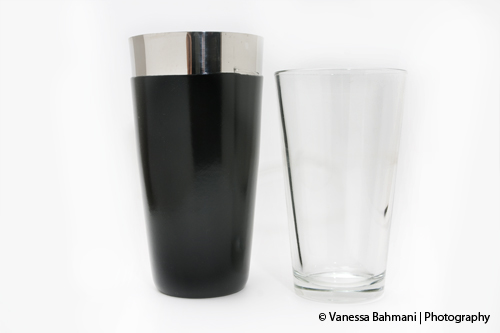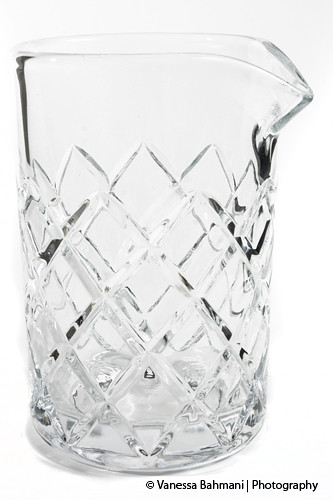Happy Hour: What's a Mixing Glass?

Back in September of last year I wrote about some of the various bar implements that a devoted cocktail geek would own. Looking back I realize it deserves a follow-up piece devoted solely to the various mixing vessels used in cocktail-making. There are shakers and there are mixing glasses, and within each category there are various types. I'll sort through the most common ones and help you figure out which is best for you based on your skill level (or the skill level you'd like to acquire).
COBBLER SHAKER
The cobbler is what most of us think of when we think of a cocktail shaker. Created in the late 19th century, the cobbler shaker is the type found in most home bars, and this near-ubiquity has made it an iconic piece of home entertaining. They come in a variety of sizes, materials, and range from the simple to the ornate. Yet most cobbler shakers are comprised the same way, made of three detachable pieces: the base cup which holds the ice and drink ingredients, a lid with built-in strainer, and a cap that fits over the strainer for when you're shaking.

To make stirred cocktails you detach the top, stir the ingredients in the base, then replace the top to strain. It's not the most ideal for stirred drinks but it gets the job done. (Read here if you need to brush up on what gets stirred and what get's shaken.)
It's the most simple to use with no learning curve, which is why it's ideal for the basic novice cocktailian who wants to make a few classic drinks without giving up anything in the style department.
BOSTON SHAKER
The Boston shaker was the first shaker ever created, predating the cobbler by decades. It's the most utilitarian, and its design has remained virtually unchanged in nearly 200 years. Although not so common in home use, the Boston is far and away the top choice of the professional bartender.
It's comprised of two pieces: a mixing tin (like the base of a cobbler) and a slightly smaller sized glass (same as a beer pint glass). The ingredients are placed in the smaller glass (ingredients are ALWAYS placed in the smaller of the two, so there's no risk of overfilling the shaker). The tin is then placed upside-down over the glass with the ingredients and given a light tap which creates an airtight seal (if done right) allowing the cocktail to be shaken without making a mess. After the cocktail is shaken, it's placed with the tin side down this time, and another quick tap releases the seal. Unlike the cobbler, the Boston requires a separate Hawthorne strainer, which is placed over the tin and the drink is strained from there.

Adding to the Boston shaker's utility is the ability to use the pint glass for stirred cocktails. Stirred drinks are traditionally strained using a julep strainer, though you can certainly let your Hawthorne do double duty. You may see some bartenders stir cocktails in the metal tin, but that's just because nobody taught them correctly. The sound of a metal spoon scraping against a metal tin is not pleasant.
Not all Boston shakers are made of the glass/tin combo however. You now see Boston shakers in which both pieces are made of tin. Many professionals, myself included, prefer this type. It is used in exactly the same way as the glass/tin combo, except the tin/tin version has a couple of advantages. Two tins are not only lighter than a tin/glass combo, but they conduct temperature much better since the whole thing is metal, resulting in a colder drink. When using the double tins however, it's appropriate to use a separate mixing glass for making stirred cocktails (more on that later).

Also unlike the cobbler shaker, the Boston does have a slight learning curve. It requires you to trust that you created a proper seal before shaking, and you'll surely screw up once or twice in the middle of shaking where the pieces will come flying apart--it even happens to professionals from time to time--but you can eventually master it with a bit of practice.
If you consider yourself more than a novice--or would like to be considered that way--then Boston will be your next stop.
MIXING GLASS
Traditionally when one referred to a mixing glass, it usually meant the pint glass of the Boston shaker. For many years this was the vessel of choice for making a stirred cocktail and it's still the most popular choice in American bars. Recently, however, a product from Japan has floated to our shores that's gotten all the cocktail geeks hot and bothered. It's a mixing glass made with a traditional Japanese "Yarai" weave pattern, and it's head and shoulders above the traditional pint glass for stirring drinks.

The Yarai mixing glass is not only visually stunning, its design also improves functionality beyond the traditional pint glass. First, unlike the pint glass of the Boston, the Yarai has a wide base which allows for fast stirring of a cocktail without fear of tipping over. Second, it has a wider mouth, which means less stuff splashes out of the glass when pouring liquids into it. This is especially helpful when pouring liquids over the ice. Third, the Yarai has a useful lip that makes pouring from it a lot easier. Finally, it's slightly larger than the pint glass in size (by about 30 ml), which means you can incorporate a little more ice, which means a colder cocktail quicker.
If your goal is to get to the summit of cocktail geekery, then you'll find the road passes through Mt. Yarai. Plus it just looks fuckin' cool.
Cheers!
*Got a cocktail question? Hit me on twitter @paystyle, email me at payman(at)lifesacocktail(dot)com, or simply drop me a comment below.
**Buy a Yarai mixing glass, or the seamless version, and various other barware over at the Umamimart Shop.
